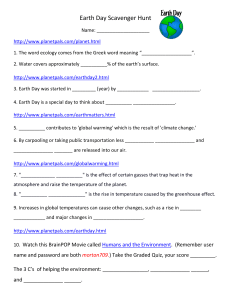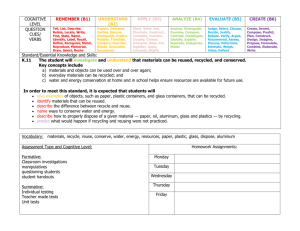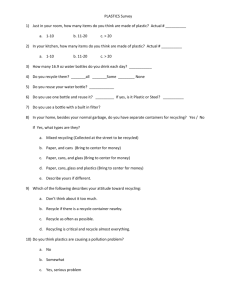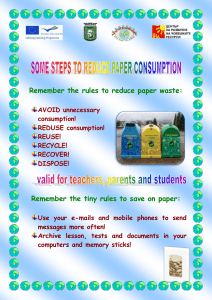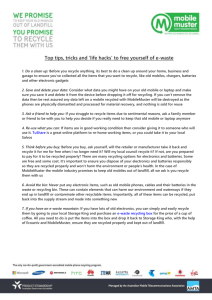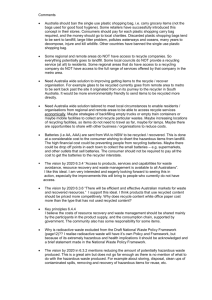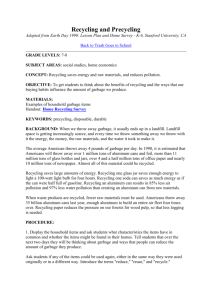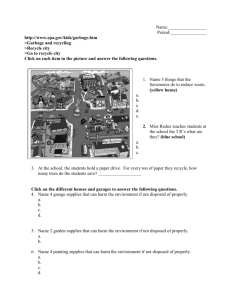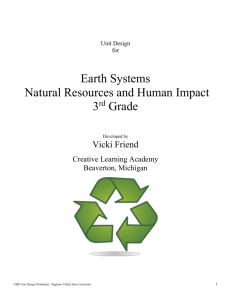Green Homes document - Alliance of Veterinarians for the
advertisement
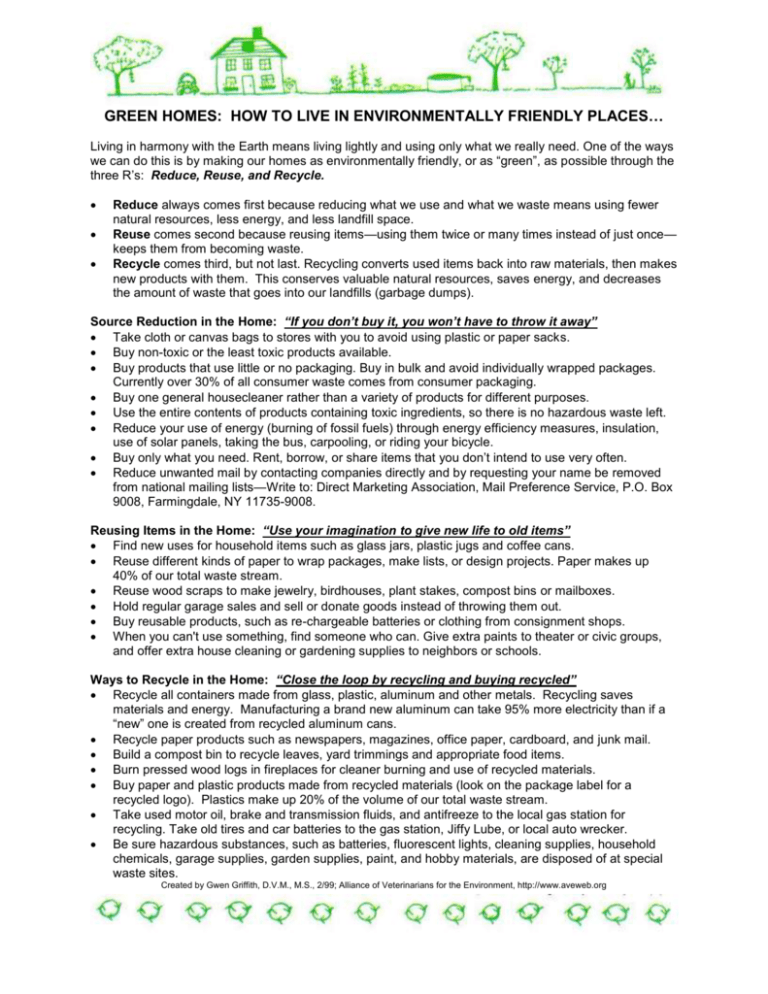
GREEN HOMES: HOW TO LIVE IN ENVIRONMENTALLY FRIENDLY PLACES… Living in harmony with the Earth means living lightly and using only what we really need. One of the ways we can do this is by making our homes as environmentally friendly, or as “green”, as possible through the three R’s: Reduce, Reuse, and Recycle. Reduce always comes first because reducing what we use and what we waste means using fewer natural resources, less energy, and less landfill space. Reuse comes second because reusing items—using them twice or many times instead of just once— keeps them from becoming waste. Recycle comes third, but not last. Recycling converts used items back into raw materials, then makes new products with them. This conserves valuable natural resources, saves energy, and decreases the amount of waste that goes into our landfills (garbage dumps). Source Reduction in the Home: “If you don’t buy it, you won’t have to throw it away” Take cloth or canvas bags to stores with you to avoid using plastic or paper sacks. Buy non-toxic or the least toxic products available. Buy products that use little or no packaging. Buy in bulk and avoid individually wrapped packages. Currently over 30% of all consumer waste comes from consumer packaging. Buy one general housecleaner rather than a variety of products for different purposes. Use the entire contents of products containing toxic ingredients, so there is no hazardous waste left. Reduce your use of energy (burning of fossil fuels) through energy efficiency measures, insulation, use of solar panels, taking the bus, carpooling, or riding your bicycle. Buy only what you need. Rent, borrow, or share items that you don’t intend to use very often. Reduce unwanted mail by contacting companies directly and by requesting your name be removed from national mailing lists—Write to: Direct Marketing Association, Mail Preference Service, P.O. Box 9008, Farmingdale, NY 11735-9008. Reusing Items in the Home: “Use your imagination to give new life to old items” Find new uses for household items such as glass jars, plastic jugs and coffee cans. Reuse different kinds of paper to wrap packages, make lists, or design projects. Paper makes up 40% of our total waste stream. Reuse wood scraps to make jewelry, birdhouses, plant stakes, compost bins or mailboxes. Hold regular garage sales and sell or donate goods instead of throwing them out. Buy reusable products, such as re-chargeable batteries or clothing from consignment shops. When you can't use something, find someone who can. Give extra paints to theater or civic groups, and offer extra house cleaning or gardening supplies to neighbors or schools. Ways to Recycle in the Home: “Close the loop by recycling and buying recycled” Recycle all containers made from glass, plastic, aluminum and other metals. Recycling saves materials and energy. Manufacturing a brand new aluminum can take 95% more electricity than if a “new” one is created from recycled aluminum cans. Recycle paper products such as newspapers, magazines, office paper, cardboard, and junk mail. Build a compost bin to recycle leaves, yard trimmings and appropriate food items. Burn pressed wood logs in fireplaces for cleaner burning and use of recycled materials. Buy paper and plastic products made from recycled materials (look on the package label for a recycled logo). Plastics make up 20% of the volume of our total waste stream. Take used motor oil, brake and transmission fluids, and antifreeze to the local gas station for recycling. Take old tires and car batteries to the gas station, Jiffy Lube, or local auto wrecker. Be sure hazardous substances, such as batteries, fluorescent lights, cleaning supplies, household chemicals, garage supplies, garden supplies, paint, and hobby materials, are disposed of at special waste sites. Created by Gwen Griffith, D.V.M., M.S., 2/99; Alliance of Veterinarians for the Environment, http://www.aveweb.org Take a Home Survey of Your Waste (Garbage, Trash and Recyclables)1 [Conduct this survey at home and then discuss the results with your parents and neighbors] 1. Put an X by the items that typically go into your trash or garbage: ___cans (aluminum or tin) ___glass bottles (what colors—clear, brown, green, other) ___aluminum foil ___styrofoam containers (cups, egg cartons, packing materials) ___cardboard ___plastic containers ___disposable diapers ___batteries ___old clothing or shoes ___grocery bags (paper or plastic) Of the items you marked with an X, which ones can be recycled? By you? By someone else? 2. Does your town/city have a place to recycle2 any of the items you marked? ___yes ___no ___??? 3. Where does your garbage go once it leaves your house? ____________________________________________________________________________________ ____________________________________________________________________________________ 4. What are some benefits to recycling things at home? ____________________________________________________________________________________ ____________________________________________________________________________________ 5. What makes recycling hard to do? Is your State different from any other state with respect to waste? ____________________________________________________________________________________ ____________________________________________________________________________________ 6. List 3 things that your family bought at the store this week which produced “instant garbage”. These items may have come packaged in such a way that as soon as you opened them, you threw parts or all of the packaging away. ____________________________________________________________________________________ ____________________________________________________________________________________ ____________________________________________________________________________________ 7. Think about disposable items. List 3 “disposable” things you or your family bought this week. Then think of alternatives to these products or other things you can use these products for before throwing them away. ____________________________________________________________________________________ ____________________________________________________________________________________ ____________________________________________________________________________________ How does it help the environment to— Reduce Waste—Decrease or stop your use of certain items? ____________________________________________________________________________________ ____________________________________________________________________________________ Reuse “Waste”—Find other new and practical uses for items? ____________________________________________________________________________________ ____________________________________________________________________________________ Recycle those things that you no longer need, but someone else might have a use for? _____________________________________________________________________________________________ _____________________________________________________________________________________________ 1 2 Adapted from EPA’s Recycle City Web Site—http://www.epa.gov/recyclecity and 50 Simple Things You Can Do To Save the Earth In the phone book, look under “Government”—“City”—“Solid Waste Management” or “Solid Waste Information” and call!

